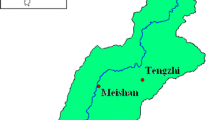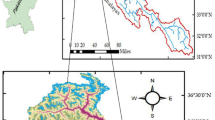Abstract
The present study evaluates the performance of hybrid machine learning models to predict flood peak due to land cover changes. Performance of feed forward neural network (FNN) and adaptive neuro-fuzzy inference system (ANFIS) was compared and analyzed to select the best model in which different conventional training algorithms and evolutionary algorithms were applied in the training process. The inputs consist of stream flow in previous time step, rainfall and area of each land use class, and output of the model is stream flow in the current time step. The models were trained and tested based on the available data in a river basin located in the Australian tropical region. Based on the results in the case study, invasive weed optimization is the best method to train the machine learning system for simulating flood peak. In contrast, some optimization algorithms such as harmony search algorithm are very weak to train the machine learning model. Furthermore, results corroborated that the performance of FNN and NFIS is the same in terms of generality. The FNN model is more reliable to predict the flood peak in the case study. Moreover, ANFIS-based model is more complex than FNN. However, ANFIS is advantageous in terms of interpretability. The main weakness of ANFIS-based model is underestimation of flood peak in the major and minor floods. Two scenarios of changing land cover were tested which demonstrated reducing natural cover might increase the flood peak more than twice.












Similar content being viewed by others
Data availability
Some or all data and materials that support the findings of this study are available from the corresponding author upon reasonable request.
References
Aadhar S, Swain S, Rath DR (2019) Application and performance assessment of SWAT hydrological model over Kharun river basin, Chhattisgarh, India. World environmental and water resources congress 2019: watershed management, irrigation and drainage, and water resources planning and management. American Society of Civil Engineers, Reston, VA, pp 272–280
Ahmad A, Ghritlahre HK, Chandrakar P (2020) Implementation of ANN technique for performance prediction of solar thermal systems: a comprehensive review. Trends Renew Energy 6(1):12–36
Almeida RA, Pereira SB, Pinto DB (2018) Calibration and validation of the SWAT hydrological model for the Mucuri river basin. Eng Agríc 38:55–63
Atashpaz-Gargari,E, Lucas C (2007) Imperialist competitive algorithm: an algorithm for optimization inspired by imperialistic competition. In: 2007 IEEE congress on evolutionary computation. IEEE, pp 4661–4667
Awan JA, Bae DH (2014) Improving ANFIS based model for long-term dam inflow prediction by incorporating monthly rainfall forecasts. Water Resour Manag 28(5):1185–1199
Bartz-Beielstein T, Branke J, Mehnen J, Mersmann O (2014) Evolutionary algorithms. Wiley Interdiscip Rev Data Min Knowl Discov 4(3):178–195
Cao W, Wang X, Ming Z, Gao J (2018) A review on neural networks with random weights. Neurocomputing 275:278–287
Cobb S (1982) Practical optimization, by PE Gill, W. Murray and MH Wright. Pp 402.£ 19·20. 1981. ISBN 0-12-283-950-1 (Academic Press). Math Gaz 66(437):252–253
Coello Coello CA, Becerra RL (2004) Efficient evolutionary optimization through the use of a cultural algorithm. Eng Optim 36(2):219–236
Cuceloglu G, Abbaspour KC, Ozturk I (2017) Assessing the water-resources potential of Istanbul by using a soil and water assessment tool (SWAT) hydrological model. Water 9(10):814
Ding S, Li H, Su C, Yu J, Jin F (2013) Evolutionary artificial neural networks: a review. Artif Intell Rev 39(3):251–260
Dokeroglu T, Sevinc E, Kucukyilmaz T, Cosar A (2019) A survey on new generation metaheuristic algorithms. Comput Ind Eng 137:106040
Formetta G, Prosdocimi I, Stewart E, Bell V (2018) Estimating the index flood with continuous hydrological models: an application in Great Britain. Hydrol Res 49(1):123–133
Gao Y, Chen J, Luo H, Wang H (2020) Prediction of hydrological responses to land use change. Sci Total Environ 708:134998
Geem ZW (ed) (2009) Music-inspired harmony search algorithm: theory and applications, vol 191. Springer, New York
Huang Y, Fu J (2019) Review on application of artificial intelligence in civil engineering. Comput Model Eng Sci 121(3):845–875
Jain NK, Nangia U, Jain J (2018) A review of particle swarm optimization. J Inst Eng India Ser B 99(4):407–411
JangaReddy M, NageshKumar D (2021) Evolutionary algorithms, swarm intelligence methods, and their applications in water resources engineering: a state-of-the-art review. H2Open J 3(1):135–188
Karaboga D (2005) An idea based on honey bee swarm for numerical optimization, vol 200. Technical report-tr06, Erciyes University, Engineering Faculty, Computer Engineering Department, pp 1–10
Katiyar S, Ibraheem N, Ansari AQ (2015) Ant colony optimization: a tutorial review. In: National conference on advances in power and control. pp 99–110
Kennedy J, Eberhart R (1995) Particle swarm optimization. In: Proceedings of ICNN'95-international conference on neural networks, Vol 4. IEEE, pp 1942–1948
Lee Y, Brody SD (2018) Examining the impact of land use on flood losses in Seoul, Korea. Land Use Policy 70:500–509
MacKay DJ (1992) Bayesian interpolation. Neural Comput 4(3):415–447
Mardquardt DW (1963) An algorithm for least square estimation of parameters. J Soc Ind Appl Math 11:431–441
Mehrabian AR, Lucas C (2006) A novel numerical optimization algorithm inspired from weed colonization. Eco Inform 1(4):355–366
Møller MF (1993) A scaled conjugate gradient algorithm for fast supervised learning. Neural Netw 6(4):525–533
Mosavi A, Ozturk P, Chau KW (2018) Flood prediction using machine learning models: literature review. Water 10(11):1536
Oyebode O, Stretch D (2019) Neural network modeling of hydrological systems: A review of implementation techniques. Nat Resour Model 32(1):e12189
Rogger M, Agnoletti M, Alaoui A, Bathurst JC, Bodner G, Borga M, Chaplot V, Gallart F, Glatzel G, Hall J, Holden J (2017) Land use change impacts on floods at the catchment scale: challenges and opportunities for future research. Water Resour Res 53(7):5209–5219
Salleh MNM, Talpur N, Hussain K (2017) Adaptive neuro-fuzzy inference system: overview, strengths, limitations, and solutions. International conference on data mining and big data. Springer, Cham, pp 527–535
Salman AM, Li Y (2018) Flood risk assessment, future trend modeling, and risk communication: a review of ongoing research. Nat Hazard Rev 19(3):04018011
Sedighkia M, Datta B (2021) Utilizing evolutionary algorithms for continuous simulation of long-term reservoir inflows. In: Proceedings of the institution of civil engineers-water management. Thomas Telford Ltd, London. pp 1–35
Sharma P, Singh A (2017) Era of deep neural networks: a review. In: 2017 8th international conference on computing, communication and networking technologies (ICCCNT). IEEE, pp 1–5
Simões K, Condé RDCC, Roig HL, Cicerelli RE (2021) Application of the SWAT hydrological model in flow and solid discharge simulation as a management tool of the Indaia River Basin, Alto São Francisco, Minas Gerais. Revista Ambiente & Água, 16.
Simon D (2008) Biogeography-based optimization. IEEE Trans Evol Comput 12(6):702–713
Stephens CM, Johnson FM, Marshall LA (2018) Implications of future climate change for event-based hydrologic models. Adv Water Resour 119:95–110
Towner J, Cloke HL, Zsoter E, Flamig Z, Hoch JM, Bazo J, Coughlan de Perez E, Stephens EM (2019) Assessing the performance of global hydrological models for capturing peak river flows in the Amazon basin. Hydrol Earth Syst Sci 23(7):3057–3080
Whitley D (1994) A genetic algorithm tutorial. Stat Comput 4(2):65–85
Funding
Not applicable.
Author information
Authors and Affiliations
Corresponding author
Ethics declarations
Conflict of interest
Not applicable.
Consent to participate
Not applicable.
Consent for publication
Not applicable.
Ethical approval
Not applicable.
Additional information
Publisher's Note
Springer Nature remains neutral with regard to jurisdictional claims in published maps and institutional affiliations.
Rights and permissions
Springer Nature or its licensor (e.g. a society or other partner) holds exclusive rights to this article under a publishing agreement with the author(s) or other rightsholder(s); author self-archiving of the accepted manuscript version of this article is solely governed by the terms of such publishing agreement and applicable law.
About this article
Cite this article
Sedighkia, M., Datta, B. Predicting impact of land cover change on flood peak using hybrid machine learning models. Neural Comput & Applic 35, 6723–6736 (2023). https://doi.org/10.1007/s00521-022-08070-y
Received:
Accepted:
Published:
Issue Date:
DOI: https://doi.org/10.1007/s00521-022-08070-y




